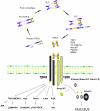TGF-β signaling in fibrosis
- PMID: 21740331
- PMCID: PMC4408550
- DOI: 10.3109/08977194.2011.595714
TGF-β signaling in fibrosis
Abstract
Transforming growth factor β (TGF-β) is a central mediator of fibrogenesis. TGF-β is upregulated and activated in fibrotic diseases and modulates fibroblast phenotype and function, inducing myofibroblast transdifferentiation while promoting matrix preservation. Studies in a wide range of experimental models have demonstrated the involvement of the canonical activin receptor-like kinase 5/Smad3 pathway in fibrosis. Smad-independent pathways may regulate Smad activation and, under certain conditions, may directly transduce fibrogenic signals. The profibrotic actions of TGF-β are mediated, at least in part, through induction of its downstream effector, connective tissue growth factor. In light of its essential role in the pathogenesis of fibrosis, TGF-β has emerged as an attractive therapeutic target. However, the pleiotropic and multifunctional effects of TGF-β and its role in tissue homeostasis, immunity and cell proliferation raise concerns regarding potential side effects that may be caused by TGF-β blockade. This minireview summarizes the role of TGF-β signaling pathways in the fibrotic response.
Figures


References
-
- Annes JP, Munger JS, Rifkin DB. Making sense of latent TGFbeta activation. J Cell Sci. 2003;116:217–224. - PubMed
-
- Bakin AV, Tomlinson AK, Bhowmick NA, Moses HL, Arteaga CL. Phosphatidylinositol 3-kinase function is required for transforming growth factor beta-mediated epithelial to mesenchymal transition and cell migration. J Biol Chem. 2000;275:36803–36810. - PubMed
Publication types
MeSH terms
Substances
Grants and funding
LinkOut - more resources
Full Text Sources
Other Literature Sources
Medical
